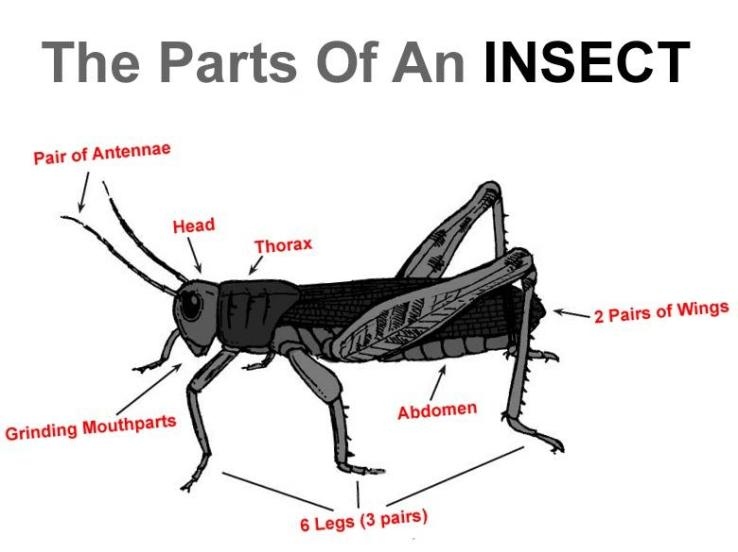
…………. pairs of legs are found in Insects.
Answer
415.2k+ views
Hint: Insects or Insecta (derived from Latin insectum) are pancrustacean hexapod invertebrates and also the largest group within the arthropod phylum. The arthropod leg is a form of jointed appendage of arthropods that is usually used for walking.
Complete Answer:
Insects have a chitinous exoskeleton with a three-part body (head, thorax and abdomen) and three pairs of jointed legs, compound eyes along with one pair of antennae. Many insects have a tripedal gait. The segments of the body are organized into three distinctive but interconnected units (tagmata): a head, a thorax and an abdomen. The thorax is made up of three segments: prothorax, mesothorax and metathorax. Each thoracic segment supports one pair of legs. The anterior segment which is closest to the head is the prothorax and has the first pair of legs and the pronotum. The middle segment is the mesothorax which has the second pair of legs and anterior wings. The third and posterior segment, abutting the abdomen, is the metathorax that features the third pair of legs and posterior wings. Each segment is delineated by an intersegmental suture. Thus, insects have 3 pairs of legs.
Insects and their relatives are, thereby, called hexapods, i.e., having six legs. Each leg has five components: the coxa, trochanter, femur, tibia, and tarsus. Each of them is a single segment, except the tarsus which can be three to seven segments, each referred to as a tarsomere. Some larval insects, however, have extra walking legs on their abdominal segments called prolegs.

Note:
Insect walking is an alternative form of locomotive option in robots. This may allow robots to traverse terrain that robots with wheels may be unable to handle. A few insects have evolved to walk on the surface of the water (especially members of the Gerridae family) commonly known as water striders. A few species of ocean-skaters in the genus Halobates even live on the surface of open oceans.
Complete Answer:
Insects have a chitinous exoskeleton with a three-part body (head, thorax and abdomen) and three pairs of jointed legs, compound eyes along with one pair of antennae. Many insects have a tripedal gait. The segments of the body are organized into three distinctive but interconnected units (tagmata): a head, a thorax and an abdomen. The thorax is made up of three segments: prothorax, mesothorax and metathorax. Each thoracic segment supports one pair of legs. The anterior segment which is closest to the head is the prothorax and has the first pair of legs and the pronotum. The middle segment is the mesothorax which has the second pair of legs and anterior wings. The third and posterior segment, abutting the abdomen, is the metathorax that features the third pair of legs and posterior wings. Each segment is delineated by an intersegmental suture. Thus, insects have 3 pairs of legs.
Insects and their relatives are, thereby, called hexapods, i.e., having six legs. Each leg has five components: the coxa, trochanter, femur, tibia, and tarsus. Each of them is a single segment, except the tarsus which can be three to seven segments, each referred to as a tarsomere. Some larval insects, however, have extra walking legs on their abdominal segments called prolegs.

Note:
Insect walking is an alternative form of locomotive option in robots. This may allow robots to traverse terrain that robots with wheels may be unable to handle. A few insects have evolved to walk on the surface of the water (especially members of the Gerridae family) commonly known as water striders. A few species of ocean-skaters in the genus Halobates even live on the surface of open oceans.
Latest Vedantu courses for you
Grade 9 | CBSE | SCHOOL | English
Vedantu 9 CBSE Pro Course - (2025-26)
School Full course for CBSE students
₹37,300 per year
EMI starts from ₹3,108.34 per month
Recently Updated Pages
Master Class 11 Economics: Engaging Questions & Answers for Success

Master Class 11 Business Studies: Engaging Questions & Answers for Success

Master Class 11 Accountancy: Engaging Questions & Answers for Success

Master Class 11 English: Engaging Questions & Answers for Success

Master Class 11 Computer Science: Engaging Questions & Answers for Success

Master Class 11 Maths: Engaging Questions & Answers for Success

Trending doubts
State and prove Bernoullis theorem class 11 physics CBSE

1 ton equals to A 100 kg B 1000 kg C 10 kg D 10000 class 11 physics CBSE

State the laws of reflection of light

One Metric ton is equal to kg A 10000 B 1000 C 100 class 11 physics CBSE

Difference Between Prokaryotic Cells and Eukaryotic Cells

1 Quintal is equal to a 110 kg b 10 kg c 100kg d 1000 class 11 physics CBSE




